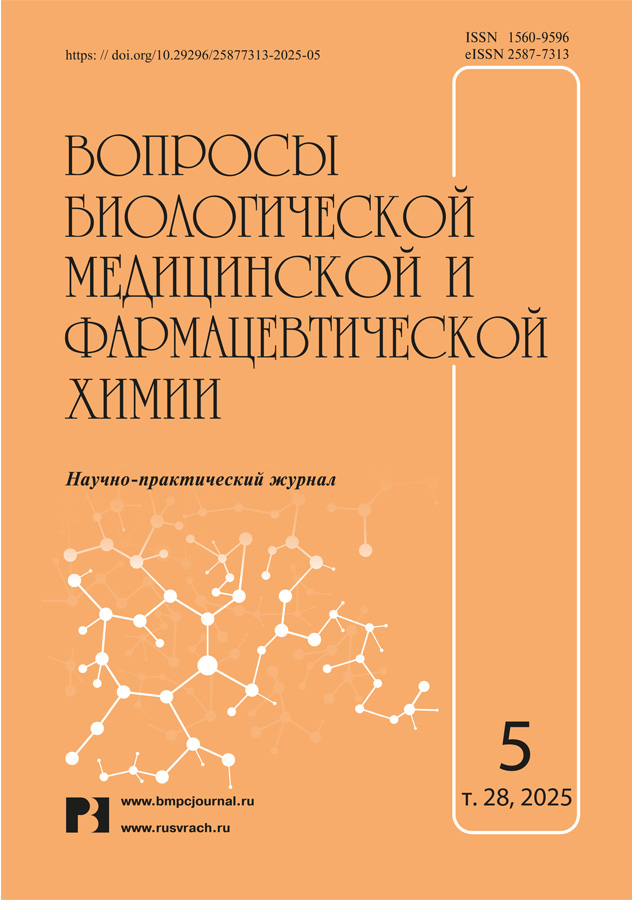Direct oral anticoagulants prescription in the elderly: predictors of adverse outcomes
- Authors: Kondrakhin A.P.1,2, Maksimov M.L.1,3, Sychev I.V.3, Shnaider K.O.1, Paskar N.G.4
-
Affiliations:
- Pirogov Russian National Research Medical University of the Ministry of Health of the Russian Federation
- State Budgetary Institution of Healthcare of Moscow "Hospital for War Veterans No. 2 of the Moscow City Health Department"
- Russian Medical Academy of Postgraduate Education of the Ministry of Health of the Russian Federation
- I.M. Sechenov First Moscow State Medical University (Sechenov University) of the Ministry of Health of the Russian Federation
- Issue: Vol 28, No 5 (2025)
- Pages: 72-76
- Section: Medical chemistry
- URL: https://journals.eco-vector.com/1560-9596/article/view/680620
- DOI: https://doi.org/10.29296/25877313-2025-05-08
- ID: 680620
Cite item
Abstract
Introduction. Due to the increasing number of geriatric patients, there is a need to improve the results of direct oral anticoagulants (POAC) use in this group – increasing the safety of drug administration, evaluation of predictors of POAC-dependent complications.
Aim – to report on possible predictors of adverse outcomes of oral anticoagulants (POACs) in the elderly.
Material and Methods. The study included 272 elderly patients with C3a-C4 chronic kidney disease (CKD). We evaluated POAC intake violation, as well as complications, their relation to the facts obtained by questionnaire and laboratory methods of investigation.
Results. The main POAK-dependent complication was "minor bleeding", which in some cases led to drug withdrawal (which could increase the risk of thromboembolic complications), however, independent drug withdrawal was quite rare and was not a reliable predictor of adverse outcomes. Nevertheless, the incidence of nosebleeds was correlated with serum creatinine level, CKF, and arterial hypertension. Apixaban was associated with a lower incidence of complications per analysis.
Conclusion. Complications per assay associated with POAC administration were more common with an ICF below 45 mL/min. Serum creatinine, stage of CKD and degree of arterial hypertension are parameters whose control may reduce the incidence of POAC-dependent complications.
Keywords
Full Text
About the authors
A. P. Kondrakhin
Pirogov Russian National Research Medical University of the Ministry of Health of the Russian Federation; State Budgetary Institution of Healthcare of Moscow "Hospital for War Veterans No. 2 of the Moscow City Health Department"
Author for correspondence.
Email: 79104851199@yandex.ru
ORCID iD: 0000-0002-3439-8059
SPIN-code: 1402-2947
Ph.D. (Med.), Chief Specialist of the Moscow City Health Department for Clinical Pharmacology
of the South-Eastern Administrative District of Moscow, Clinical Pharmacologist, Senior Lecturer of the Pharmacology Department of the Institute of Pharmacy and Medical Chemistry
M. L. Maksimov
Pirogov Russian National Research Medical University of the Ministry of Health of the Russian Federation; Russian Medical Academy of Postgraduate Education of the Ministry of Health of the Russian Federation
Email: maksim_maksimov@mail.ru
ORCID iD: 0000-0002-8979-8084
SPIN-code: 6261-3982
Kazan State Medical Academy, Dr.Sc. (Med.), Professor, Head of the Department of Clinical Pharmacology and Pharmacotherapy, Professor of the Department of Pharmacology, Dean of the Faculty of Preventive Medicine and Healthcare Organization
Russian Federation, st. Ostrovityanova, 1, Moscow, 117513; 2/1, building 1, Barrikadnaya st., Moscow, 125993; Butlerova street, 36, Tukay square, Kazan, 420012I. V. Sychev
Russian Medical Academy of Postgraduate Education of the Ministry of Health of the Russian Federation
Email: sychev_iv@bk.ru
ORCID iD: 0000-0003-0227-2651
Junior Research Scientist, Research Institute of Molecular and Personalized Medicine
Russian Federation, 2/1, building 1, Barrikadnaya st., Moscow, 125993K. O. Shnaider
Pirogov Russian National Research Medical University of the Ministry of Health of the Russian Federation
Email: 79104851199@yandex.ru
ORCID iD: 0000-0002-0630-4238
SPIN-code: 9979-2700
Assistent
Russian Federation, st. Ostrovityanova, 1, Moscow, 117513N. G. Paskar
I.M. Sechenov First Moscow State Medical University (Sechenov University) of the Ministry of Health of the Russian Federation
Email: nnikpaskar@yandex.ru
ORCID iD: 0009-0002-6656-6667
SPIN-code: 8269-0440
Student of the A.P. Nelyubin Institute of Pharmacy
Russian Federation, 8/2, Trubetskaya str., Mosсow, 119991References
- Максимов М.Л., Бонцевич Р.А., Бурашникова И.С. и др. Клиническая фармакология и рациональная фармакотерапия для практикующих врачей: учебник / Под ред. проф. М.Л. Максимова. Казань: ИД «МеДДоК». 2021; 948 с. [Maksimov M.L., Boncevich R.A., Burashnikova I.S. i dr. farmakologiya i racional`naya farmakoterapiya dlya praktikuyushhix vrachej: uchebnik / Pod red. prof. M.L. Maksimova. Kazan`: ID «MeDDoK». 2021; 948 s. (In Russ.)].
- Lubbe A.L., van Rijn M., Groen W.G. et al. The quality of geriatric rehabilitation from the patients' perspective: a scoping review. Age Ageing. 2023 Mar 1; 52(3): afad032. doi: 10.1093/ageing/afad032.
- Ellis G., Sevdalis N. Understanding and improving multidisciplinary team working in geriatric medicine. Age Ageing. 2019 Jul 1; 48(4): 498–505. doi: 10.1093/ageing/afz021.
- Joosten L.P.T., van Doorn S., van de Ven P.M. et al. Safety of Switching from a Vitamin K Antagonist to a Non-Vitamin K Antagonist Oral Anticoagulant in Frail Older Patients with Atrial Fibrillation: Results of the FRAIL-AF Randomized Controlled Trial. Circulation. 2024 Jan 23; 149(4): 279–289. doi: 10.1161/CIRCULATIONAHA.123.066485.
- Saczynski J.S., Sanghai S.R., Kiefe C.I. et al. Geriatric Elements and Oral Anticoagulant Prescribing in Older Atrial Fibrillation Patients: SAGE-AF. J Am Geriatr Soc. 2020 Jan; 68(1): 147–154. doi: 10.1111/jgs.16178.
- Okumura K., Akao M., Yoshida T. et al. ELDERCARE-AF Committees and Investigators. Low-Dose Edoxaban in Very Elderly Patients with Atrial Fibrillation. N Engl J Med. 2020 Oct 29; 383(18): 1735–1745. doi: 10.1056/NEJMoa2012883.
- Debette S., Mazighi M., Bijlenga P. et al. ESO guideline for the management of extracranial and intracranial artery dissection. Eur Stroke J. 2021 Sep; 6(3): XXXIX–LXXXVIII. doi: 10.1177/23969873211046475.
- Polidori M.C., Alves M., Bahat G., Boureau A.S. et al. Atrial fibrillation: a geriatric perspective on the 2020 ESC guidelines. Eur Geriatr Med. 2022 Feb; 13(1): 5–18. doi: 10.1007/s41999-021-00537-w.
- Demelo-Rodriguez P., Galeano-Valle F., Proietti M. Use of Oral Anticoagulant Drugs in Patients with Pulmonary Hypertension. Heart Fail Clin. 2023 Jan; 19(1): 97–106. doi: 10.1016/j.hfc.2022.08.018.
Supplementary files












